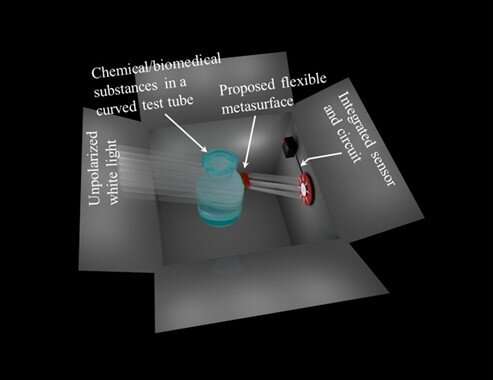A metaholographic platform that detects light exposure

During the COVID-19 pandemic last year, an incident occurred where vaccines exposed to room temperature had to be discarded. Biomedical substances, including vaccines, risk deterioration if not stored properly, so strict management is required during production and storage. In particular, exposure to light may reduce the vaccine's efficacy, so it is important to check whether it has been damaged by light exposure.
Recently, a POSTECH research team led by Professor Junsuk Rho (Department of Mechanical Engineering and Department of Chemical Engineering) and Ph.D. candidate Joohoon Kim (Department of Mechanical Engineering) has collaborated with Dr. Jonghyun Choi (The New Zealand Institute for Plant and Food Research Ltd.) to propose a novel sensor platform that detects light exposure using a "universal metahologram," which can not only operate under all states of polarizations, but also transmit multiple lights.
A metahologram made of metamaterials is a technology that displays different holographic images depending on the direction of incident light. Its applicability in next-generation displays and as security sensor was highly anticipated as it can display multiple images simultaneously.
However, a limitation existed in which a metahologram that operates in all incident polarizations could only express a limited number of colors. Conversely, metaholograms that show different colors only respond to certain incident polarizations.
To overcome this limitation, the research team successfully fabricated a metahologram that emits brilliant colors regardless of any incident light. Moreover, it was confirmed that this new metahologram can be used as a sensor when attached to a container designed for storing a chemical or biomaterial to detect light exposure. The research team particularly increased the possibility of large commercial manufacturing for metaholograms by developing a printing process that replicates them over flexible substrates.
The research findings can be useful for secure packaging and transportation of light-sensitive chemical or biomedical substances. The technology can be applicable in intelligent packaging and labeling to prevent counterfeits and to verify the authenticity of agricultural and fishery products such as honey and kiwi, or secondary processed foods exported by New Zealand.
The research was published in ACS Applied Materials and Interfaces.
More information: Muhammad Ashar Naveed et al, Single-Step Fabricable Flexible Metadisplays for Sensitive Chemical/Biomedical Packaging Security and Beyond, ACS Applied Materials & Interfaces (2022). DOI: 10.1021/acsami.2c09628
Journal information: ACS Applied Materials and Interfaces
Provided by Pohang University of Science & Technology (POSTECH)





















